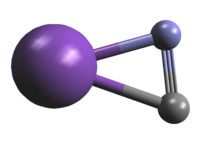|
The molecule is nearly T-shaped with the KN bond slightly
shorter than the KC bond. Therefore, the molecule should be
considered more as potassium isocyanide rather than as
potassium cyanide.
The experimental measurements were taken from
(1) P. Kuijpers, T. Törring, and A. Dymanus,
1976, Chem. Phys. Lett. 42, 423;
(2) T. Törring, J. P. Bekooy, W. L. Meerts, J. Hoeft,
E. Tiemann, and A. Dymanus,
1980, J. Chem. Phys. 73, 4875;
(3) J. J. van Vaals, W. L. Meerts, and A. Dymanus,
1984, J. Mol. Spectrosc. 106, 280.
The spectroscopic parameters used for the current predictions
have been reported in
(4) J. H. He, D.-V. Trung, S. Kwok, H. S. P. Müller,
T. Hasegawa, T. C. Peng, and Y. C. Huang,
2008, Astrophys. J. Suppl. Ser. 177, 275.
Transitions with uncertainties larger than 100 kHz
have not been merged.
The predictions should be fairly reliable as long as the
predicted uncertainties do not exceed 1.0 MHz.
While in the laboratory b-type transitions have been
observed, their intensities are liekly very small because
the b dipole moment component is about 1.5 orders
of magnitude smaller than the a component; hence,
transitions will be about three orders of magnitude weaker.
Hyperfine structure splitting caused by the 14N nucleus
or the 39K nucleus are not of relevance for
astronomical observations.
The ab initio dipole moment was taken from
(5) H. S. P. Müller, unpublished.
|
